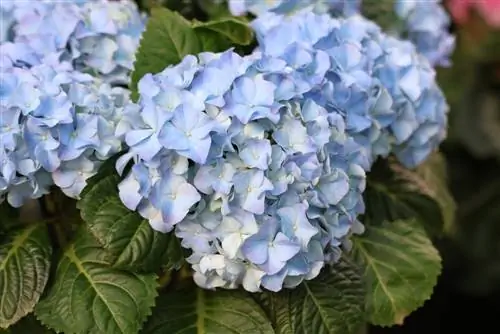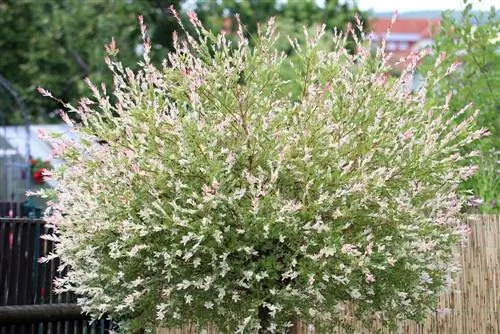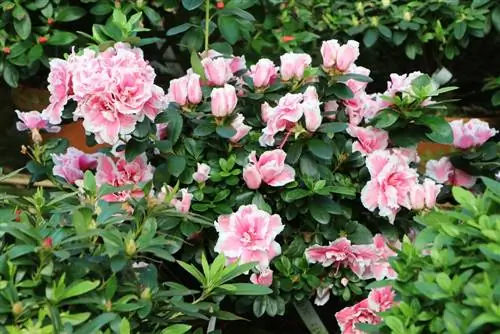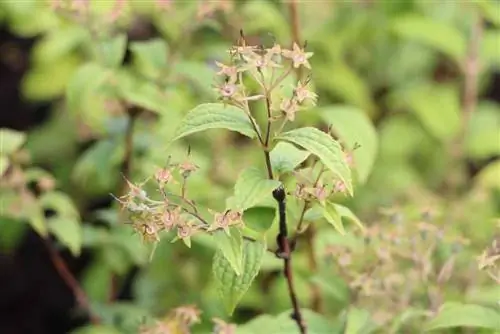- Author admin [email protected].
- Public 2023-12-17 03:39.
- Last modified 2025-01-24 12:45.
Due to its namesake stripes, zebra grass is one of the most unusual grasses in our domestic ornamental gardens. Since it is also frugal and actually easy to care for, it can be found more and more often in ponds and herbaceous beds. To ensure that the joy of this decorative plant continues uninterrupted in the following year, we explain here how and when to cut back the zebra grass correctly.
Why cut?
The main care measure for Miscanthus sinensis zebrinus, the scientific name of zebra grass, is cutting. Why it, like all other representatives of miscanthus, is essential from a gardening point of view is due to the following reasons:
Annuality of foliage
Initial situation:
Although zebra grass is actually a perennial plant, this does not apply to the above-ground parts of the plant, i.e. the leaves. They die with the onset of winter and begin to dry out and rot over time.
Aim of the cut:
By removing the dead leaves, the dead plant mass, which becomes increasingly unsightly over time, is removed, so that the well-known and popular stripes of the young, strong leaves come to the fore.
Rot
Initial situation:
As the dead leaves degenerate, they form a dense “cluster” of dead biomass that rests on the actual root ball and represents an ideal breeding ground for rot, mold and other parasites.
Aim of the cut:
By removing the dead leaf mass, the development of harmful influences on the plant is removed and the susceptibility of zebra grass is significantly reduced.
Shielding
Initial situation:
As it grows throughout the year, the zebra grass forms a dense clump of leaves, which only slowly breaks down after it dies off in the winter. For the new leaves that emerge in spring, it provides almost complete protection against light and water, the two most important sources of life in the growth of a plant.
Aim of the cut:
The possibilities for exposure, ventilation and irrigation of the new young shoots are significantly improved and their development is positively influenced.
The right time

Now that it is clear why you should definitely cut back zebra grass in your home garden, the right time to cut it needs to be clarified. Some hobby gardeners may be tempted to remove the dry, brown leaves in autumn and thus go into the winter break with a tidy and well-prepared garden for spring. But there are good reasons why the right time to cut zebra grass is in spring, before growth begins:
- Good frost protection for the root ball thanks to dead leaves on the grass
- Good protection of the plant from intense winter precipitation
- Good wintering opportunities for numerous small and micro creatures in the foliage, also good building material for winter storage of small mammals
If you consider, on the one hand, the pruning required to avoid rot in the roots and at the same time the protection provided by the dead leaves from too much water and cold, this initially appears to be a contradiction. However, the foliage actually protects in winter, while during this time putrefaction bacteria and mold are also inhibited in their growth and do not develop or only develop to a limited extent. Only in spring, with rising temperatures, should the risk of infestation be averted by removing the leaves.
Tip:
In order to use the winter protection of the dead leaf clump for as long as possible, pruning can be done when the first fine leaf tips of the new shoots come out of the ground.
Cut correctly
In order to carry out the cut correctly, there are a few simple aspects to consider:
- Use sharp, sufficiently large garden or household scissors
- Wear protective gloves to avoid cuts from sharp leaf edges
- Cut the grass straight a few centimeters above the ground
- Carry out the cut in such a way that the leaves are not severely frayed or torn, as tearing leaf bases can damage the roots right down to the ground
- Avoid damage to the new young shoots
- When pruning after sprouting, cut a few centimeters above the new shoots
What to do if the cut is wrong?

It can happen again and again that mistakes are made when cutting the zebra grass. Even then nothing is lost, as the common errors can be fixed relatively easily:
Cutting in autumn
If the zebra grass is stripped of its dead leaves in the fall, the protective effect that the leaves actually have is missing in the winter.
Possible remedies:
- Covering the root ball with brushwood, straw or coconut mats
- IMPORTANT: do not use airtight covers such as foil or rubber mats
Cut too late
If you overlook the new shoots in spring, they may grow to a considerable size between the old leaves. A comprehensive cut of the entire eyrie is then no longer possible.
Possible remedy
- If the growth height is low, cut upwards and leave the residue higher
- Cut out dead leaves individually or in small clusters between the young shoots
- ATTENTION: Be sure to avoid injuring the new leaves, otherwise they will die from the injury upwards






